Full Length Research Paper
ABSTRACT
Ricinodendron heudelotii is a wild oil tree species native to sub-Saharan Africa. It is also found in Benin. Its oil is rich in the essential fatty acids (Omega 3, 6), fat-soluble vitamins (A, D, E and K) and trace elements, essential for human health. Currently, few people know about this oil, likely explaining its almost total absence in rural markets in Benin. The species is also neglected, as little scientific data is available on it in Benin, particularly regarding knowledge on its uses where it occurs. With the aim of filling this gap, ethnobotanical surveys were undertaken to assess the uses of the species, identify factors explaining the variation of its ethnobotanical value, and determine its availability and accessibility for local people. Data were analysed using the relative frequency of citation and generalised linear models. In total, eight uses were enumerated, of which six were for medicinal uses and one for cosmetic and handcraft respectively, and mainly based on its stem. The stem of R. heudelotii was mainly used for handcraft by Nagot and Holli socio-linguistic groups and mainly by men from the Pobe phytodistrict. Although individuals of R. heudelotii were absent in southern Benin, its kernel is mainly used for cosmetics and medicine by people from the Fon socio-linguistic group in this region. Field data suggest that the kernels and oil of R. heudelotii in this region mainly come from Cameroon and Côte d’Ivoire. The distance travelled to access the species at the time of this study is two times higher than 30 years before and positively correlated with the use-value (r=0.66, P-value<0.001). Our findings suggest that R. heudelotii is marginally used in Benin, and this might be a threat for its conservation and related knowledge.
Key words: Commercial value, ethnobotanical value, phytodistrict, seed oil, kernel, use-value, West Africa
INTRODUCTION
Oil plants are important resources for human livelihoods, especially in sub-Saharan Africa (OCDE and FAO, 2018). They provide direct products to satisfy household needs, including cosmetics, food, fuel, medicine, etc. The oils provide food rich in energy, vitamins, and essential fatty acids, especially in places, where malnutrition remains a challenge (van der Vossen and Mkamilo, 2007). Seed oils ranked highest (41%) as agricultural products most traded on international markets (OCDE and FAO, 2018). This proportion is expected to remain stable throughout the period (2018–2027), especially in West Africa (OCDE and FAO, 2018).
The seed oil sector occupies an important place in the economies of West African countries (that is, Benin, Burkina Faso), with an average annual added value of nearly 157 million USD (UEMOA, 2013). The sector contributes significantly to the creation of wealth and jobs in West African countries. However, the region is still net importer of seed oils with the total annual importation of seed oil into the region amounting 250,000 tons (UEMOA, 2013). For decades this sector has therefore been confronted by difficulties linked to its low level of global competitiveness (price hike of locally produced seed oils, low production capacity and yield) and a high penetration of similar foreign products or substitutes (UEMOA, 2013). Due to the deficit of seed oils in West Africa, and particularly in Benin, edible wild trees/shrubs bearing seeds with a high oil content can play a significant role in meeting the demand for seed oil. Ricinodendron heudelotii (Bail.) Pierre is one such species in Benin. It is used daily by local people, but its potential has been neglected from a scientific perspective including its contribution to households’ livelihoods. For more than three decades, this species has been involved in several development programs of food security in Sub-Saharan Africa countries, including Cameroon, Democratic Republic of Congo, Gabon, Ghana, Côte d’Ivoire, Nigeria (Ndumbe et al., 2019).
The seed oils produced in Benin come primarily from Elaeis guineensis Jacq. (oil palm), Gossypium sp. (cotton), Glycine max (L.) Merr. (soya), Arachis hypogaea L. (peanut), Sesamum indicum L. (sesame), Vitellaria paradoxa C. F. Gaertn. (shea) and Anacardium occidentale L. (cashew) (Cruz et al., 2019; MAEP, 2008). R. heudelotii seed oil, less known and used across the country, can, however have important unsuspected nutritional, medicinal and cosmetic properties whose potentials is far from fully exploited (Codjia et al., 2015). In addition, with global climate change, the integration of resilient endogenous crops adapted to the local environment is necessary for sustainability of the seed oil sector.
R. heudelotii is a tree of the humid, semi-dry, wooded-savannah zone and distributed in the Central and West African countries. It is found in areas up to 1200 m altitude, with mean annual rainfall of 900 to 3500 mm, and is mainly found on medium textured, freely draining/acidic soils (van der Vossen and Mkamilo, 2007). Several studies (Arrey, 2018; Assanvo et al., 2015; Ogbuagu et al., 2019) have demonstrated the high importance of the physico-chemical properties and fatty acid profiles of the seed oil of this species. For instance, il extracted from the kernels of R. heudelotii contains 86.9–87% unsaturated fatty acids (oleic, linoleic, linolenic and α-eleostearic acids), 189.24-190.5 mg KOH/g saponi?cation value, and 155-160 g I2/100 g Iodine value (Arrey, 2018; Assanvo et al., 2015; Ogbuagu et al., 2019). With such properties, the oil of R. heudelotii exhibits anti-cancerogenic, anti-mutagenic and anti-inflammatory activities (Arrey, 2018). The seeds of R. heudelotii are highly valued in countries such as Cameroon (Ezekwe et al., 2014), Côte d’Ivoire (Assanvo et al., 2015) and Nigeria (Ogbuagu et al., 2019) in the cosmetic, food and medicine industries.
Despite the importance of this species in other regions of the continent (Ndumbe et al., 2019), there have been few scientific attempts to elucidate its uses and socio-economic importance in Benin where it also occurs (Akoègninou et al., 2006). As a first attempt to fill the gap, this study focused on the local uses and socio-economic values of the species and its seed-derived products. In addition, its neglect could lead to the erosion of the species uses and potential valuations by rural populations.
Knowledge on local uses as well as the socio-economic importance of plants is essential to reveal their value and how they can be managed to sustainably support livelihoods of rural people (Saad et al., 2019). Several studies have shown that the uses and socio-economic values of plant species in various places are linked to socio-cultural characteristics of the surveyed people. The importance of studying variations in the uses of a plant across cultural groups lies in the fact that relationships between people and nature may differ from one cultural group to another. As such, within a single geographical or ecological area, people's perceptions and practices of natural resource management and their use at the local level may vary with their background and ancestral inheritance (Avocévou-Ayisso et al., 2012).
The overall objective of this research was to assess the ethnobotanical knowledge on the uses and the socio-economic importance of R. heudelotii. Specifically, the study aimed to: (i) assess the diversity of uses of R. heudelotii, (ii) determine socio-demographic factors explaining the variation of its ethnobotanical value, and (iii) assess the species availability and accessibility for local populations.
MATERIALS AND METHODS
The study was conducted in five phyto-geographical districts of Benin: the Bassila and south Borgou phyto-districts in the sub-humid zone, and the Plateau, Pobe, and coastal phytodisticts in the humid zone (Figure 1). These phytodistricts are areas where the species are naturally distributed in Benin (Akoègninou et al., 2006). However, many native species in the country have experienced severe decline and threatened extinction due to anthropogenic activities (M'Woueni et al., 2019).
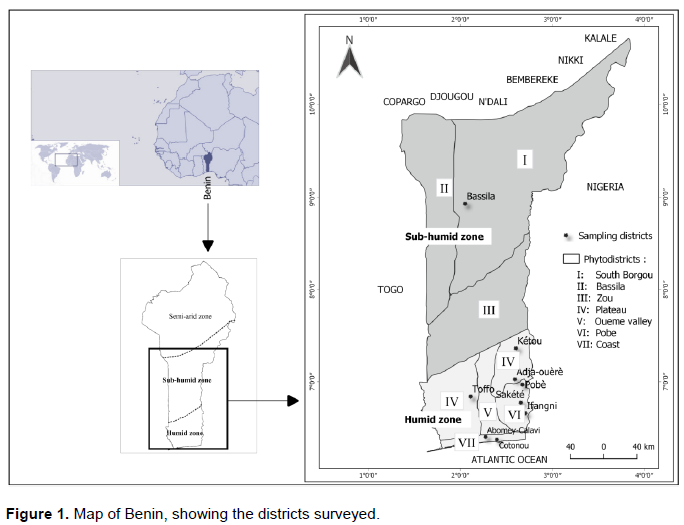
The population density is higher in the humid zone compared to the sub-humid and semi-arid zones (INSAE, 2015), and with quite diverse socio-linguistic groups. The Benin resident population was about 11,200,000 inhabitants in 2017 (UNDP, 2018), and was mainly young (more than 40% were under 15 years old) and slightly female-biased (51%). The local economy is dominated by agricultural activities, which are practiced by more than 70% of the population.
In Benin, poverty remains widespread, with national poverty rates of 36.8% in 2018 (UNDP, 2018). Non-Timber Forest Products (NTFPs) play a crucial role in the food security, nutrition, health, and income generation of the rural poor, and in developing adaptations to cope in the event of climate change (Heubach et al., 2011). For instance, Adansonia digitata L., Tamarindus indica L., Vitellaria paradoxa C. F. Gaertn., and Parkia biglobosa (Jacq.) R. Br. ex G. Don are reported as commercialised NTFPs in Benin, and they are mainly used for subsistence purposes (Assogbadjo et al., 2017).
Sampling design
An exploratory survey was first conducted in two localities, where the species or its parts are found in each phytodistrict based on the literature surveys. In each of these localities, 30 respondents (both male and female) from different age groups were asked whether they know and use the species. The proportion of positive responses was considered and used in the binomial approximation of the Dagnelie normal distribution (Dagnelie, 1998) to determine the sample size, that is, the number of people to survey by phytodistrict (Table 1):
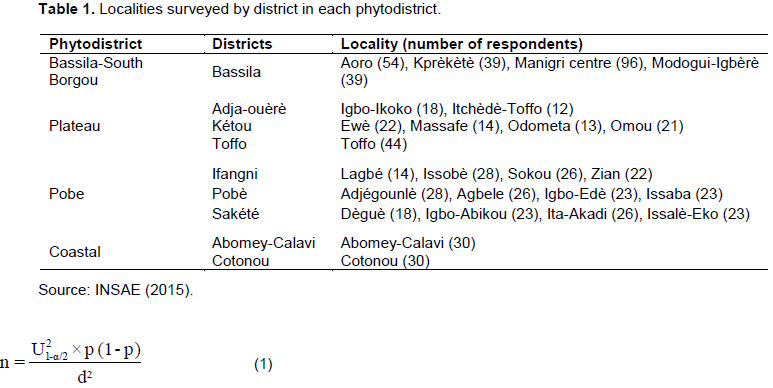
In Equation 1, n = sample size in the village; U1-α/2 = 1.96, is the value of the random normal variable for a probability value of α = 0.05 (1−α/2 = 0.975); p = proportion of individuals with knowledge of the species. The value considered for p is 0.5 and gives the maximum possible sample size with a margin of error d set at 0.08 considering the budget and operational constraints for the survey.
In total, 768 people were surveyed (60 people in the Coastal phytodistrict, 210 in Plateau, 270 in Pobe and 228 in Bassila-South Borgou). The respondents were selected and balanced by gender and age to ensure the full participation of women and young people in the surveys. The respondents were mainly uneducated (74.3%) and farmers (35.4%). The Nagot socio-linguistic group (56.4%) was the most surveyed. Three age categories were considered (<30 years for young people; ≥30 to <60 years for adults; and ≥60 years for old people). The distribution of respondents according to socio-demographic characteristics is presented in Appendix 1.
.png)
Data collection
Data were collected using individual interviews with the help of a local assistant translator. Interviews were conducted in the different localities with the consent of the head of the household or any person representing the household's authority at home or at the market where traders were interviewed. The following data were collected: (i) the socio-demographic characteristics of the respondent, (ii) the diverse uses of the species, (iii) the socio-economic importance of the species, (iv) whether there are taboos or not on the species, (v) the types of habitats where the species components are harvested, (vi) the perceived availability of the species, (vii) the estimated distance in km, travelled to harvest the species components at the time of data collection, and 30 years back in the past, and (viii) the potential substitute species. Socio-demographic data of the respondent included the respondent’s age, educational level, gender, professional activity, and socio-linguistic group. In terms of the socio-economic importance of the species, we focused on all components used on the species and their market prices.
Data analysis
Ethnobotanical value of R. heudelotii trees
Analyses focused on the uses, use-value and commercial value of the species. The relative frequency of citation (RFC, %) was used to assess the salience of each specific use (Friedman et al., 1986).

In Equation 2, Ni is the number of respondents that reported the specific use i; N is the total number of respondents for the species. RFC was calculated for each use per phytodistrict (RFC).
To assess the overall use-value of the species, and test how it varied with phytodistrict and factors such as respondents’ age, educational level, gender, professional activity, and socio-linguistic group, we calculated the use-value (UV) following Phillips and Gentry (1993).

The use-value was also calculated for kernels. In Equation 3, Uis is the number of specific uses mentioned by respondent i (varied from 0 to 6 (maximum Uis) for the whole plant and for the kernels from 0 to 3; ni is the total number of interviews for species s with respondents i (ni = 1).
The effect of the socio-demographic factors on UV of the species was tested using the Poisson generalised linear model. The full model, that is, the one including all main effects and possible interactions, was fitted first, and subsequently simplified using the likelihood ratio test. The UV was further compared among use-categories (cosmetics, handcraft, and medicine). Principal component analysis was used to describe the relationship between socio-linguistic groups and the use-categories and components.
The commercial value of kernels (as the main commercialised component of R. heudelotii) was expressed as the proportion of respondents who mentioned that the species has a market value (Lozano et al., 2014). The relationship between each socio-demographic factor and the commercial value was assessed using a Chi-square test. The currency exchange rate of 1 dollar (USD) to 554 FCFA (XOF) was applied (28/10/2020) for monetary conversion.
Availability and accessibility of R. heudelotii trees
The RFC was used to assess the local perception of the habitats of the species and its availability. The difference between the estimated distances travelled in the 30 past years compared to time the data were collected was tested using a student t test as an indicator of changes in the species accessibility. Finally, Pearson correlation was used to test the link between the use-value and the estimated distance the respondent travels to get the species. This distance is an indicator of how much energy the respondent could invest to access the species and we expected that the higher the UV, the higher the distance the respondent could travel to have access to the species, hence a positive relationship between UV and this distance.
RESULTS
Ethnobotanical value of R. heudelotii trees
Local names and their meanings
Different local names were used to designate R. heudelotii depending on socio-linguistic groups (Table 2). However, similar designations were also used by some socio-linguistic groups (e.g., Erimando used by the Holli and Nagot). Likewise, within the same socio-cultural group, different designations were also used to designate the species, for example, Apki, Akpèma, and Apkopkotin used by the Fon. The meanings of the local names, in general, referred to the morphology of its components (e.g., the shape of its leaf), and to the role and uses of the species (e.g., Egui guèlèdè meaning tree used to craft the masks of Guèlèdè, an art and cultural Yoruba dance). Nagot socio-cultural group considered the species as the king of all the trees in the forest.
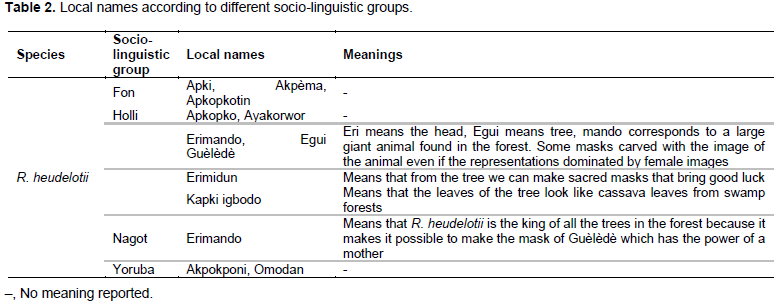
Uses of R. heudelotii
Eight (8) uses were enumerated for R. heudelotii, of which six were for medicine and one for cosmetic and handcraft respectively. The handcraft use was mostly observed in Pobe phytodistrict (e. g., to carve Guélèdè mask and wood statue by using stems), while the cosmetic uses were mostly reported in the Coastal phytodistrict where individuals of the species are rather absent. The seeds of R. heudelotii were used for their kernels. The kernels were used to tone and swell their buttocks and breasts and to treat females' infertility problems. Leaves and bark were also used to treat infants’ walking difficulty, dysmenorrhea, cough, dizziness, and anemia (Table 3).
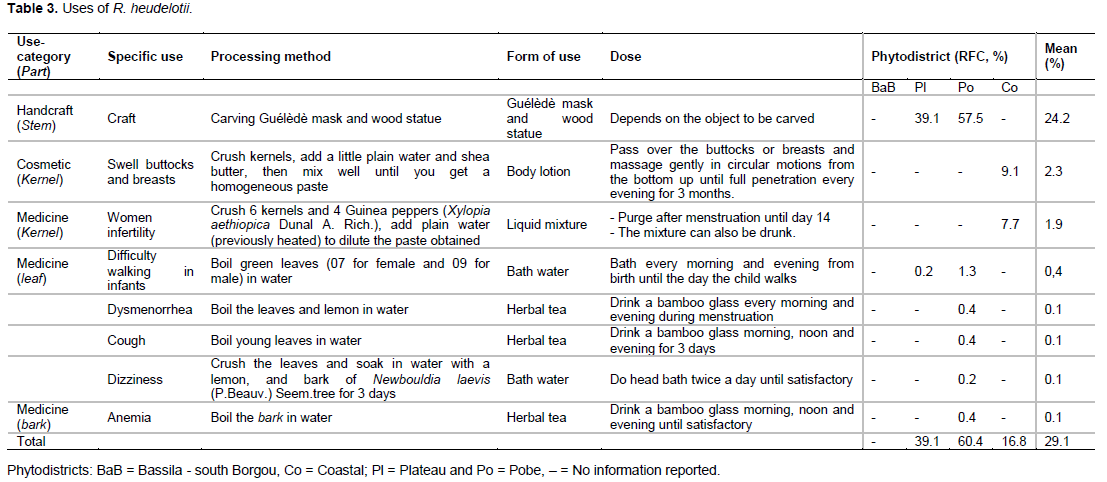
Gender, phytodistricts, professional, and socio-linguistic groups were found to significantly influence (P <0.05) the species use. Particularly, the use-value was higher for men (1.15 ± 1.01), people from the Nagot (1.15 ± 1.08) and Holli (1.14 ± 0.55) socio-linguistic groups, people involved in the handcraft activities (1.59 ± 1.37), and people living in the Pobe phytodistrict (1.81 ± 1.05). No use was enumerated by people belonging to the Anii and Lokpa socio-linguistic groups in the Bassila and south Borgou phytodistricts (Figure 2a-d).
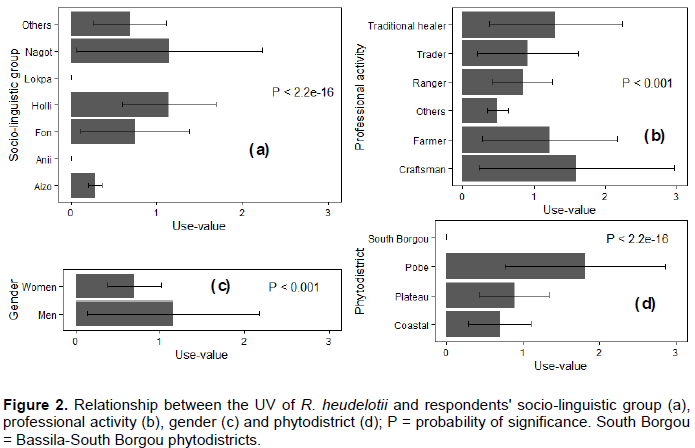
Relationships between socio-linguistic groups and use-categories and components
Results from the Principal Component Analysis (PCA) showed strong correlations (| correlation | ≥ 0.5) between uses and sociolinguistic groups. More specifically, Fon socio-linguistic group used the kernel in cosmetics and medicine while the Nagot and Holli groups were mainly associated with the use of the species’ stem for handcraft (Figure 3a, b). However, the other socio-linguistic groups such as Aïzo, Anii, and Lokpa showed a low relationship with the uses of R. heudelotii (Figure 3a, b).
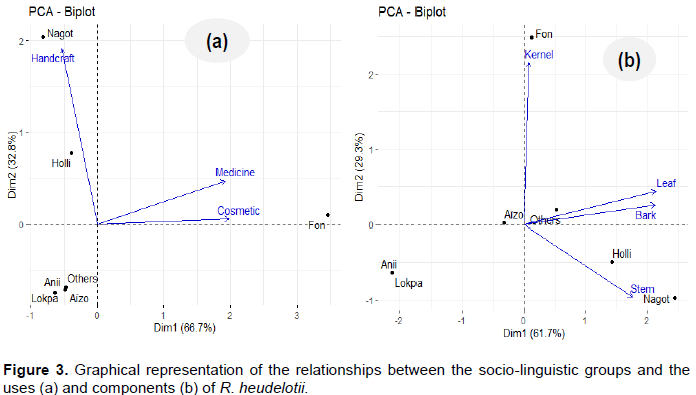
Use and commercial values of R. heudelotii kernels
The kernel was mainly used for cosmetic and medicine. There was a significant difference (P < 2.2e-16) in its use-value among use categories, with the highest use-value for cosmetics (0.62 ± 0.48), while the lowest for medicines (0.13 ± 0.12). In addition, gender, education, phytodistrict, and professional activities had significant effects on the use-value of the R. heudelotii kernels (P < 0.05). The highest use-value of R. heudelotii kernels was mainly observed in the following groups: women, Fon socio-linguistic group, people involved in the commercilization of the species, university education, secondary and primary educational levels (that is, educated people), and people who lived exclusively in the Coastal phytodistrict (Figure 4a-d).

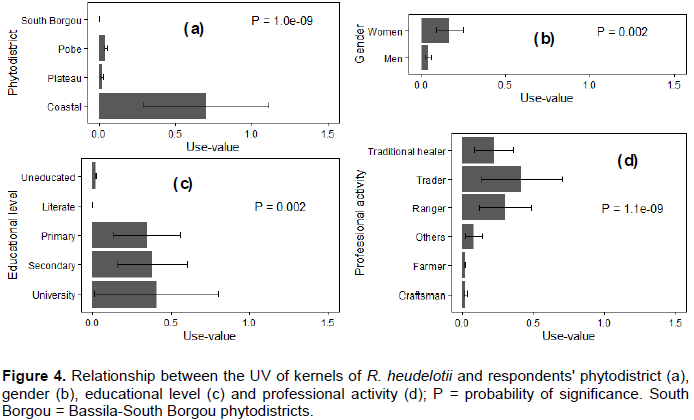
The Kernels are sold in cities, such as Abomey-Calavi, Cotonou, Parakou, and Porto-Novo. The kernels were sold in 50–200 g plastic boxes or bags. The price of the kernels was 2000 XOF (3.61 USD) per 120 g. The price of the oil was 10,000 FCFA (18.05 USD) per litre. Most of the stakeholders in the commercilization of the kernels were women who imported the kernels from Cameroon and Cote d’Ivoire. Moreover, in the absence of this kernel, respondents reported that fenugreek (Trigonella foenum-graecum L.) kernels were used as a substitute for the same uses.
Availability and accessibility of R. heudelotii
R. heudelotii trees were generally found in forest ecosystems (Figure 5a). The species users reported that they now travel twice longer distance (7.07 ± 0.52 km) than 30 years back in the past (3.60 ± 0.12 km), to harvest the parts of the species (Figure 5b, c). The estimated distance that the species users were likely to travel to collect the species was positively correlated with the use-value of R. heudelotii trees (Pearson correlation coefficient = 0.66, t = 24.619, df = 766, P < 2.2e-16), indicating that the higher the UV, the more the species users are willing to travel longer distance to access the resource.

DISCUSSION
This study examined the ethnobotanical knowledge on the uses of R. heudelotii, and its socio-economic importance. The local populations used and named R. heudelotii under various designations. Its designation was different across socio-linguistic groups. The meanings of its local names were in reference to the morphology of its components or the cultural importance. The specificity of these names in the different local languages shows that the species is known by the different socio-linguistic groups surveyed. This observed specificity also suggests a long history of use of these species by the respondents (Assogbadjo et al., 2017). Nevertheless, most socio-linguistic groups were unable to give the meaning of the local names of the species. This likely resulted from the influence of modernization on folk lifestyles, which was then causing the ancestral knowledge erosion (Gaoue et al., 2017).
R. heudelotii is used for cosmetic, handcraft, and medicinal purposes, indicating relatively diverse the uses of the species. The diversity of the uses of this species is however relatively poor compared to that of other wild oil plants used in the same geographical areas, such as V. paradoxa, for which about 16 uses were reported (van der Vossen and Mkamilo, 2007). In addition, for this same species (R. heudelotii), more uses were cited in various other countries of West African, including Cameroon (Ezekwe et al., 2014), Côte d’Ivoire (Assanvo et al., 2015), and Nigeria (Ogbuagu et al., 2019) with an average of almost twenty uses reported. Such trends suggest that knowledge about the species is still rudimentary in Benin, and are evidence of the opportunities until so far unseized by local communities.
The most used components of the species are the stem, the leaves and the bark. In particular, the stem of R. heudelotii is used for Guèlèdè masks as also reported by Boko-Haya et al. (2017). Unfortunately, stem harvesting chops entire branches and destroys the whole plant (Yaoitcha et al., 2015), thus compromising the survival of individuals of the species. Given the importance of the species for local communities, their involvement in the definition of conservation strategies is essential because they will undoubtedly benefit from collective support and is essential in the process of perpetuating the various services it provides.
Knowledge about the stem, leaves, bark, and seeds of the species was found to vary according to the education, gender, phytodistricts, professional activities, and socio-linguistic groups, suggesting a possible spatial and ethnic specialisation in the use of these components of the species in Benin. In addition, Fon socio-linguistic group was found to be the main user of the kernel in cosmetic and medicine, while the Nagot and Holli groups were mainly associated with the use of the species’ stem for handcraft. Other socio-linguistic groups such as Aïzo, Anii, and Lokpa showed a low relationship with the uses of the species’ components. The specificities in the uses may be related to its abundance and distribution. Indeed, its availability at given times in various environments is a determining factor in the level and evolution of the knowledge of the uses. The cultural differences of the respondents may explain the different levels of knowledge recorded because, according to Assogbadjo et al. (2017), the nutritional habits of a population are fundamentally based on cultural norms. In fact, different communities may develop unique plant knowledge because they are exposed to diverse environmental conditions, ailments, and cultural practices (Avocévou-Ayisso et al., 2012). Ancestral knowledge of the plants' virtues was also transmitted from generation to generation and specific to the context and history of each group community (Assogbadjo et al., 2017).
Seeds of R. heudelotii have a commercial value, confirming the potential of the species in improving household income. However, the commercial value of the seeds in Benin is extremely low compared to their value in other countries in West Africa. For example, R. heudelotii seeds had about 50 times higher commercial value in Cameroon (Cosyns et al., 2011). This thus confirms that the seeds of the species are still undervalued in Benin.
Once again, the commercialisation of seeds and seed- linguistic and professional groups in the phytodistricts, indicating that the use of the seeds of this species is also spatially, ethnically and gender-influenced. The commercialisation of the kernels and oil of R. heudelotii shows a certain socio-economic interest for local populations, in particular for women. Similar observations were reported by Assanvo et al. (2015), Ogbuagu et al. (2019), and Saad et al. (2019). Notably, respondents reported that the kernel of R. heudelotii used in Benin is imported from Cameroon and Côte d’Ivoire, despite its availability in the country. This could be because the tree has been considered sacred since time immemorial for its strictly cultural interest (Guèlèdè dance) for local communities: it is named ‘the king of all the trees in the forest' by the Nagot socio-linguistic group. Guèlèdè masks carved from the stems of R. heudelotii are considered sacred objects and are not intended for sale. It should also be noted that the Guèlèdè dance was classified in 2008 as an oral and intangible heritage of humanity by UNESCO in order to avoid the loss of this traditional knowledge and to revitalise it (https://ich.unesco.org/en/RL/oral-heritage-of-gelede-00002).
Beyond the cultural restriction, the non-exploitation or under-exploitation of this resource, however locally available (see e.g. of R. heudelotii sheaths in Bassila-South Borgou, Pobe, and Plateau phytodistricts), could be explained by a poor knowledge of its virtues. This challenges the reliability of the oral mode of transmitting knowledge, making information vulnerable in the long term (Ouédraogo et al., 2013). These results showed that the knowledge that is retained over time is generally limited to what responds better to the environment, emerging trends, and the inherent needs of younger generations. Indeed, apart from the seeds, the other parts of plants (bark, leaves, roots, and stems) of this species were not yet subject to commercial exchanges either inside or outside the country.
R. heudelotii occurs naturally mostly in forest ecosystems with declining populations under the threat of anthropogenic pressures. The trees are mainly found in undisturbed or less disturbed areas. Moreover, findings confirmed that the higher the UV, the more ready folks are to brave long distances to harvest the parts they need, indicating how users are depending on the species, probably as there are not suitable substitutes in surrounding ecosystems. In fact, only one substitute of the species was reported by respondents (Trigonella foenum-graecum L.). This reinforces the need for more effort for the domestication of the species.
CONCLUSION
The findings of this study show that R. heudelotii has only 8 uses; stems are used for handcraft and its kernels for medicinal and cosmetic purposes. Its use and commercial values are associated with gender, phytodistrict, professional activity and socio-linguistic group. They contribute to household income and represent potential important business opportunities to be realized. Knowledge generated in this study clearly shows that the species potential is far from being well exploited in Benin. The organisation and promotion of this resources will not only boost the local economy, but will also improve household incomes and the fabric of society, and will eventually reduce the level of poverty in Benin.
CONFLICT OF INTERESTS
The authors have not declared any conflict of interests.
ACKNOWLEDGEMENTS
This research was funded by the University of Abomey-Calavi (Project ‘WILD-OIL /2018/PFCR III/UAC’) and the International Foundation for Science, Stockholm, Sweden through a grant to the first author (No D-6345-1). IDEA-WILD Foundation provided equipment support to the first author for the field work. The authors are grateful to the local people for kindly sharing their precious knowledge and time and to everyone who provided introductions to local people.
REFERENCES
|
Akoègninou A, Van Der Burg J, Van Der Maesen L (2006). Flore analytique du Bénin, Cotonou and Wageningen: Backhuys Publishers. |
|
|
Arrey IT (2018). Enzyme-assisted aqueous extraction of Njangsa (Ricinidendron heudelottii) seed oil. |
|
|
Assanvo EF, Gogoi P, Dolui SK, Baruah SD (2015). Synthesis, characterization, and performance characteristics of alkyd resins based on Ricinodendron heudelotii oil and their blending with epoxy resins. Industrial Crops and Products 65:293-302. |
|
|
Assogbadjo AE, Idohou R, Chadare FJ, Salako VK, Djagoun CAMS, Akouehou G, Mbairamadji J (2017). Diversity and prioritization of non timber forest products for economic valuation in Benin (West Africa). African Journal of Rural Development 2(1):105-115. |
|
|
Avocévou-Ayisso C, Avohou TH, Oumorou M, Dossou G, Sinsin B (2012). Ethnobotany of Pentadesma butyracea in Benin: A quatitative approach. Ethnobotany Research and Applications 9:151-166. |
|
|
Boko-Haya YY, Ouinsavi AINC, Houngbeme GA, Gbaguidi F, Agbangla C (2017). Traditional Uses, Phytochemistry And In Vitro Evaluation of Toxicity of Ricinodendron Heudelotii (Baill Pierre Ex Heckel) Leaves In Benin. International Journal of Recent Scientific Research 8(10):21227-21236. |
|
|
Codjia JTC, Assogbadjo AE, Idohou AFR, Honfo SH, Tovissode CF, Chadare FJ, Ekué MRM, Yorou NS (2015). Espèces ligneuses sauvages alimentaires du Bénin: Biodiversité et perspectives de gestion. Bibliothèque Nationale du Bénin. |
|
|
Cosyns H, Degrande A, De Wulf R, Van Damme P, Tchoundjeu Z (2011). Can commercialization of NTFPs alleviate poverty?: a case study of Ricinodendron heudelotii (Baill.) Pierre ex Pax. Kernel marketing in Cameroon. Journal of Agriculture and Rural Development in the Tropics and Subtropics 112(1):45-56. |
|
|
Cruz JF, Hounhouigan DJ, Havard M, Ferré T (2019). La transformation des grains. Collection Agricultures tropicales en Poche, Quæ, Presses agronomiques de Gembloux, CTA, Versailles, Gembloux, Wageningen. 182 p. + cahier quadri 16 p. |
|
|
Dagnelie P (1998). Statistiques théoriques et appliquées, de Boeck et Larcier. Brux Belg. |
|
|
Ezekwe MO, Besong SA, Johnson R (2014). Nutritive composition of omega-3 fatty acids-rich Ricinodendron heudelotii and its potential for nutrition. International Journal of Nutrition and Metabolism 6(6):56-62. |
|
|
Friedman J, Yaniv ZAD, Palewitch D (1986). A preliminary classification of the healing potential of medicinal plants, based on a rational analysis of an ethnopharmacological field survey among Bedouins in the Negev Desert, Israel. Journal of ethnopharmacology 16(2-3):275-287. |
|
|
Gaoue OG, Coe MA, Bond M, Hart G, Seyler BC, McMillen H (2017). Theories and major hypotheses in ethnobotany. Economic Botany 71(3):269-287. |
|
|
Heubach K, Wittig R, Nuppenau EA, Hahn K (2011). The economic importance of non-timber forest products (NTFPs) for livelihood maintenance of rural west African communities: A case study from northern Benin. Ecological Economics 70(11):1991-2001. |
|
|
INSAE (2015). RGPH4: que retenir des effectifs de population en 2013?. Ministère du Développement de l'Analyse Economique et de La Prospective. Direction des Etudes démographiques. Cotonou, République du Benin P 35. |
|
|
Lozano A, Araújo EL, Medeiros MFT, Albuquerque UP (2014). The apparency hypothesis applied to a local pharmacopoeia in the Brazilian northeast. Journal of Ethnobiology and Ethnomedicine 10(1):2. |
|
|
M'Woueni D, Gaoue OG, Balagueman RO, Biaou HS, Natta AK (2019). Road mediated spatio-temporal tree decline in traditional agroforests in an African biosphere reserve. Global Ecology and Conservation 20:e00796. |
|
|
MAEP (2008). Stratégie d'opérationnalisation et déclinaison en plans d'investissements sectoriels de la vision Bénin 2025 «Agenda vers une économie émergente » Rapport Final, Ministère de l'Agriculture, de l'Elevage et de la Pêche (MAEP) 171 p. |
|
|
Ndumbe LN, Ingram V, Tchamba M, Nya S (2019). From trees to money: the contribution of njansang (Ricinodendron heudelotii) products to value chain stakeholders' financial assets in the South West Region of Cameroon. Forests, Trees and Livelihoods 28(1):52-67. |
|
|
OCDE and FAO (2018). OCDE and FAO, Perspectives agricoles 2018-2027, Éditions OCDE, Paris / Organisation des Nations Unies pour l'alimentation et l'agriculture, Rome. (accessed July 21, 2020). |
|
|
Ogbuagu A, Eric S, Obumselu F, Ogbuagu J (2019). Qualitative and Quantiative Phytochemical and Physicochemical Analyses on The Oil and Extracts from Ricinodendron Heudelotii. Chemical and Pharmaceutical Research 1(1):1-7. |
|
|
Ouédraogo A, Lykke AM, Lankoandé B, Korbéogo G (2013). Potentials for Promoting Oil Products Identified from Traditional Knowledge of Native Trees in Burkina Faso. Ethnobotany Research and Applications 11:71-83. |
|
|
Phillips O, Gentry AH (1993). The useful plants of Tambopata, Peru: I. Statistical hypotheses tests with a new quantitative technique. Economic Botany 47(1):15-32. |
|
|
Saad N, Zin NKM, Suhaimi SA, Rusli MEF, Ismail N, Mastuki SN, Rosli R (2019). Ricinodendron heudelotii (Njangsa): Composition, Nutritional Values and Product. In Wild Fruits: Composition, Nutritional Value and Products. Springer pp. 301-311. |
|
|
Union Economique et Monétaire Ouest-Africaine (UEMOA) (2013). Etude de faisabilité et d'élaboration d'un programme d'action détaillé pour la promotion des filières oléagineuses graines de coton et du palmier a huile dans l'espace UEMOA (Union Economique et Monétaire Ouest-Africaine). Rapport provisoire. Volume 1 : Bilan diagnostic et programme d'actions 223 p. |
|
|
United Nations Development Programme (UNDP) (2018). Human Development Indicators and Indices: 2018 Statistical Update Team. 123 p. |
|
|
Van der Vossen HAM, Mkamilo GS (2007). Plant Resource of Tropical Africa 14. Vegetable oils. PROTA Fondation, Wageningen, The Netherlands. Backhuys Publishers, Leiden 237 p. |
|
|
Yaoitcha AS, Houehanou TD, Fandohan AB, Houinato MRB (2015). Prioritization of useful medicinal tree species for conservation in Wari-Maro Forest Reserve in Benin: A multivariate analysis approach. Forest Policy and Economics 61:135-146. |
|
Copyright © 2024 Author(s) retain the copyright of this article.
This article is published under the terms of the Creative Commons Attribution License 4.0